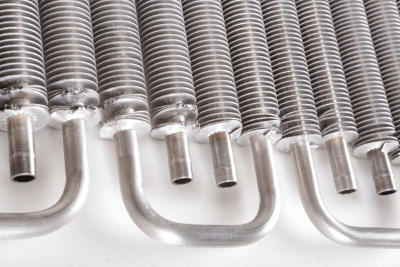What Is a Fin Tube?

Fin tubes are tubes with fins attached to the outer circumference of a metal tube.
A fin is a metal wing-shaped component inside a heat exchanger that is attached to the surface of a tubular heat exchanger to increase its surface area, thereby improving the heat transfer performance of the heat exchanger. Fins are usually made of metals with high thermal conductivity, such as aluminum or copper.
Fins allow efficient heat exchange to improve equipment performance and enable compact designs. Fin tubes are widely used in various fields, such as air conditioning equipment, automobile radiators, and power plant coolers.
Applications of Fin Tubes
1. Automotive Industry
Fin tubes are used in engine coolers and air conditioning system coolers. In large vehicles such as buses and trucks, they are also used in engine oil coolers and transmission oil coolers.
2. Refrigeration and Air Conditioning Industry
Used in cooling towers, air conditioners, freezers, refrigerators, frozen vehicles, etc.
3. Electric Power Industry
Used in cooling towers, heat exchangers, and other coolers in power plants. It is also used in reactor coolers in nuclear power plants.
4. Chemical and Petrochemical Industries
Used in heat exchangers for petroleum refining equipment, petrochemical plants, chemical plants, etc.
5. Food and Beverage Industry
Used in heaters, coolers, distillers, drying equipment, etc. Examples include beer and beverage coolers and coffee machine heaters.
6. Medical Industry
Used in medical heaters and coolers, such as MRI (magnetic resonance imaging) machines.
7. Oil and Gas Industry
Used in heat exchangers and heaters for oil drilling. Also used as a heat insulator for pipelines.
8. Construction Industry
Used in air conditioning equipment such as heaters, heat pumps, and air conditioners. It is also used in renewable energy sources such as geothermal and solar thermal applications.
Properties of Fin Tubes
1. Heat Conductivity
Fin tubes improve the heat exchange rate by increasing the surface area of the fins. Fins are usually made of aluminum alloy and have high thermal conductivity.
The fins of fin tubes are characterized by their fine shape. The reason is to transfer more heat by increasing the surface area of the fins. Thus, fins with high thermal conductivity and large surface area allow fin tubes to efficiently exchange heat.
2. Compact Design
Fin tubes can exchange the same amount of heat in a more compact design than a standard heat exchanger. This is because the use of fins reduces the length of the tube required to achieve the same heat transfer area. The fins increase the surface area, which improves the heat transfer coefficient, resulting in more efficient heat exchange.
For example, in aircraft heat exchangers, a large amount of heat exchange area must be placed in a limited space. Fin tubes have a compact design and high heat exchange performance, enabling efficient heat exchange even in a small space such as an aircraft.
In some cases, space is also limited in factories. Fin tubes can be installed in smaller spaces with the same heat exchange capacity, thus improving space efficiency in factories.
3. Flexibility
Fin tubes are flexible because they can be manufactured in a variety of shapes and sizes depending on the requirements of the heat exchanger. For example, small fin tubes can be used when the heat exchanger needs to be installed in a small space, while large fin tubes can be used when a large amount of heat needs to be transferred.
4. Corrosion Resistance
Aluminum fins are made of an aluminum alloy and are suitable for many chemical environments because of their corrosion resistance. This is one reason why fin tubes are widely used. Aluminum alloys are lightweight and durable. They also have high thermal conductivity and transfer heat efficiently due to their high thermal conductivity.
5. Vibration Resistance
Fin tubes have a strong structure against mechanical vibration because the fins and tubes are integrated into one piece. Therefore, it can be used in mobile equipment such as vehicles, ships, and construction machinery, as well as in buildings where vibration is high. For example, in the engine room of a ship, vibrations caused by the engine and the sea can cause vibration.
6. Long Life
Fin tubes are usually made of aluminum alloys, which are highly corrosion-resistant and have excellent thermal conductivity. In addition, the joints between fin tubes and fins are welded or soldered together to ensure that the joints are firmly fixed, making them highly reliable for long-term use. Fin tubes are therefore widely used in buildings, machinery, and other facilities and equipment that must operate stably over long periods.
Other Information on Fin Tubes
Maintenance of Fin Tubes
Fin tubes are easy to maintain because they are installed inside heat exchangers. Fin tubes themselves may need to be replaced, but it is easy to do so without having to disassemble the entire heat exchanger. Also, since fin tubes are made of metal, periodic cleaning can remove deterioration and dirt, thus maintaining the performance of the heat exchanger.